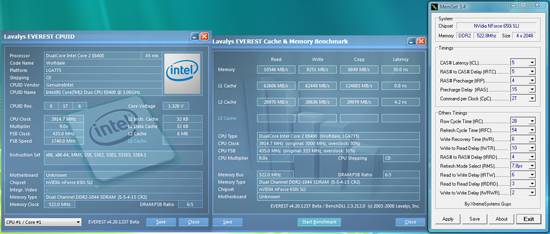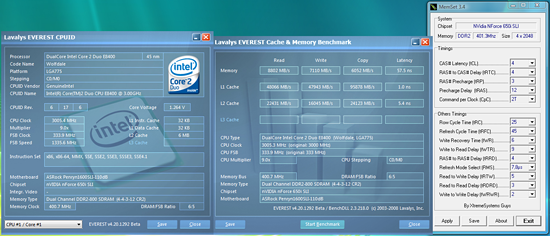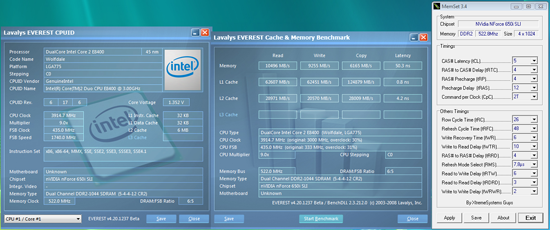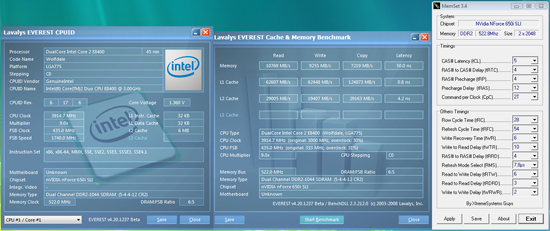ASRock Penryn 1600SLI-110dB : Penryn on the 650i, are you kidding me?
by Gary Key on February 15, 2008 12:00 PM EST- Posted in
- Motherboards
E8400 8GB 9x435 -
 |
| Click to enlarge |
E8400 8GB 9x333 -
 |
| Click to enlarge |
The first two screenshots show a final setting of 9x435FSB with the E8400 dual-core processor. This results in a final CPU speed of 3.91GHz at 1.375V. We utilized a 4x1GB and 2x2GB memory configuration at DDR2-1044 with 5-4-4-12 timings on 2.2V. This particular CPU is a recent retail purchase that will reach 4.1GHz with 1.3625V on an X48 board. We could POST at 9x445 but Crysis reared its ugly head and prohibited us from running at a higher FSB rate even with reduced memory speeds or increased timings. We had to set VTT to 1.375V, GTLRef to High, HT Link speed to 800MHz, and SPP voltage to 1.382V for stability.
Unfortunately, we could not change the CPU multiplier with the current 1.00 BIOS so maximum FSB rates are not available. However, we believe this board will probably do around 450FSB which is perfectly acceptable considering this FSB range usually maximizes performance with the right memory settings on this chipset.
Our 8GB memory configuration also resulted in a 9x435FSB setting with memory at DDR2-1044 at 5-5-4-15 timings on 2.2V. We had to set VTT to 1.42V. GTLRef to High, HT Link speed to 600MHz, and SPP voltage to 1.382V. We wish the BIOS had a 2.25V setting to ensure a little extra headroom for stability. The next setting after 2.20V is 2.31V and is outside the voltage recommendations for this memory. Our board operated fine but the increase in VTT voltage and decrease in HT link speeds were required to pass the benchmark test suite. In the end, these settings and resulting performance on this chipset with 8GB installed is exceptional.
Once again the board exhibited very good Vdroop levels with idle around -.01V raising to -.03V under load. We have included a stock 9x333 screenshot as a reference point. Memory timings and performance results at stock settings were equal between the 4GB and 8GB setups.
Overall, the overclocking performance of this board with the E8400 and QX9650 is good, certainly not the best we have seen with the Intel chipsets, but perfectly acceptable given the board's target market. In all cases, once the various voltage and memory timings were dialed in, the board proved to be extremely stable. This is a very good indicator that ASRock can fine tune additional performance and hopefully address a few of our requests for improvements. They have already responded with a new BIOS release that we are testing currently.
Quick Thoughts -
ASRock is one of those companies that people tend to either love or hate. A lot of people wouldn't even consider purchasing a budget oriented motherboard, choosing to live by the old adage "you get what you pay for". However, based on what we have seen out of ASRock in the past few months, we would not hesitate to recommend this board for someone looking for a solid gaming platform, especially if SLI is important. We say this without showing the rest of our cards on the table, but this board is already a diamond in the rough for those looking to marry an E8400 with a couple of 8800GT's. How it will fair in the end against the likes of the abit IP35-E and Gigabyte GA-P35-DS3L is something we will answer shortly.












29 Comments
View All Comments
Odeen - Saturday, February 16, 2008 - link
1) Why the sudden urge to name a motherboard after the S/N ratio of the sound codec? Intel and (real) Asus boards with Soundmax codec chips, and pretty much anything with 24-bit audio processing capability can lay claim to supporting that high of a S/N ratio, yet only Asrock uses it in the model name.2) Having the ATX connector behind the CPU is SO 1999 and/or SO Epox. Just picture the ATX cable running to that location if you have a case with a bottom-mounted PSU (Such as the Antec P180/182). Do Do you drape the cable over the CPU cooler, or run it underneath? If you run it underneath, doesn't it push down on the video card? Lame.
3) Why do only Asrock and ECS feel the need to silkscreen words on the PCB. Oh look, we have "Gigabit lan" support. Oh wow, it's "DDR2" memory slots. Every 650i motherboard has dual core support, but only Asrock needs to brag about it through motherboard labels.
Nothing against the board (with the exception of the ATX connector). Just saw the picture of it, and the thoughts of every ECS board I've ever used came back :)
chrnochime - Monday, February 18, 2008 - link
....And yet you have no problem with silly names like Asus' "Maximus Formula" or "StrikerII Formula"? Or Abit's "QuadGT"? I mean what kind of weird name is QuadGT? Is that a car? Or Abit Fatal1ty" Or Asus' use of "Republic of Gamers"?Sheesh...
Jjoshua2 - Saturday, February 16, 2008 - link
I'm glad the 110db isn't the sound level of a 5000+rpm fan on the chipset.JEDIYoda - Saturday, February 16, 2008 - link
seems to me as if you have issues with ASRock and ECS.....Personally again what are your issues in regards to this areticle??
imaheadcase - Saturday, February 16, 2008 - link
The ATX conneceter is fine, it just hooks to the PS, most just drape the remaing cable on backside of motherboard or on top of the PS.Its not a big deal with modular PS.
Heidfirst - Saturday, February 16, 2008 - link
It's not the only 650i SLI claiming Penryn support ...Mr Alpha - Saturday, February 16, 2008 - link
With the memory prices being what they are I've been putting a lot of thought to a 4x2GB RAM configuration. Overclocking and compatibility fears has stayed my hand though. Can I expect to see more about a 8GB memory configuration in future articles?Rajinder Gill - Saturday, February 16, 2008 - link
We will be incorporating both 4GB/8GB testing with the 2GB modules in our upcoming reviews. You are right, the current pricing is attractive, with 2x2 modules for 4GB becoming the wiser choice for performance oriented Vista 64 systems.regards
Raja
defaultex - Sunday, June 23, 2013 - link
Having overclocked my Q9450 on a MSI P7N Diamond Deluxe to 3.6Ghz stable. Now I'm using the same board listed in the article. Here are my findings thus far.On two sets of memory I have around it does not seem to detect the memory voltage or frequency correctly, it does at least detect timings correctly. Setting those manually in the BIOS reduced memory faults to a miniscule amount, leaving it at auto produced up to 50 faults per second in heavy programs.
Chipset voltage had to be bumped up a notch or two in order to get Windows to boot. This scares me since my previous board died from pushing the NB voltage over 1.4v. However the NB temp is much more stable than my previous board so it may not be an issue.
The VTT had to be bumped to stabalize Windows. Note that you should never push the VTT over your processors maximum rated voltage, doing so will damage the processor (though the damage may not be noticeable at first).
I hit a FSB hole at 390-410Mhz. Any frequencies in that range failed to POST, but going over it with the same voltages for 380Mhz worked with random haults inside of Windows (need to tweak the voltages a bit).